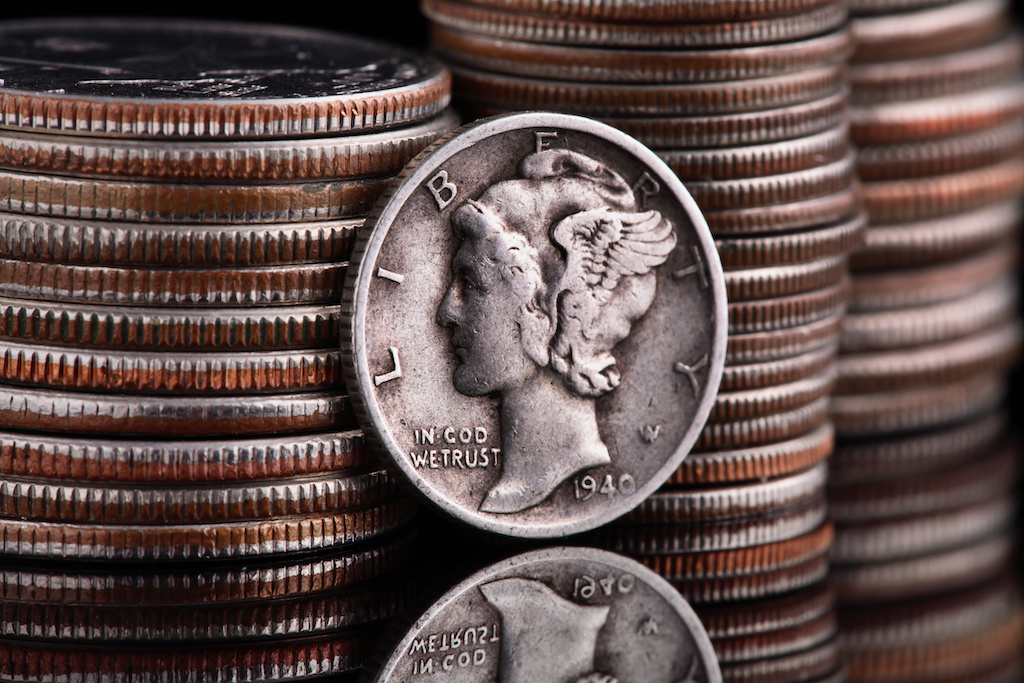Collecting the Roosevelt dime is a fascinating hobby because it can involve finding rare and valuable coin errors. While this dime may be common in circulation today, some issues can be worth far more than their face value due to minting errors, special editions, and unique variations.
Roosevelt dimes offer potential value beyond their face amount, especially in high-grade or uncirculated conditions. Finding one of these five coins in circulation can be a lucky discovery.
1967 Roosevelt Dime
Since the 1967 dime has no silver content, its market value is determined by condition and collector interest. In circulated conditions, a typical 1967 dime is worth its face value of 10 cents.

In lower uncirculated grades (MS60), it can be worth around $1 to $2. In higher uncirculated grades (MS65), the value rises to $3 to $5. Special Mint Set (SMS) coins from 1967 can be worth $5 to $15, depending on their condition and grade.
| Grade | Estimated Value Range |
|---|---|
| Circulated Grades (Good to About Uncirculated) | Face value to $0.50 |
| Lower Uncirculated (MS60) | $1 to $2 |
| Higher Uncirculated (MS65+) | $3 to $5 |
| Special Mint Set (SMS) | $5 to $15 |
Numismatists have discovered that some 10-cent coins from the 1967 mintage have errors during minting, such as off-center strikes, doubled dies, and other mistakes that can increase their value. Depending on the degree of the error, a 1967 Roosevelt dime with a mistake is valuable, even in circulated conditions.
1996-W Roosevelt Dime
The 1996-W dime was produced at the West Point Mint as part of a special collector’s set to celebrate the 50th anniversary of the Roosevelt dime.

This ten-cent coin wasn’t released into general circulation but was part of the US Mint 1996 Uncirculated Coin Set.
The “W” mint mark is rare for a Roosevelt dime, as West Point generally produces commemorative coins and bullion, not circulating coinage. The unique mint mark makes this dime stand out as a limited-edition piece. Some of these dimes have entered circulation, making them rare and valuable finds if discovered.
The 1996-W Roosevelt Dime is worth between $20 and $50 in uncirculated condition. Depending on its condition, collectors may pay more for higher grades.
1968 No-S Proof Roosevelt Dime
The 1968 No-S Proof Roosevelt Dime is among modern US coinage’s most notable and valuable error dimes.

In 1968, the San Francisco Mint inadvertently struck some proof coins without the “S” mint mark. This error occurred because the die used to strike the proof coins was not correctly marked with the “S,” leading to a small number of proof dimes without the “S” mint mark.
NGC Certified 1968 “No S” 10 cents coin graded PF68, worth more than $40,000
The Proof 1968 Dime without the mint mark is valued at around $15,000 to $20,000, depending on market demand. Coins in near-perfect condition have been known to sell for over $40,000.
1982 No Mint Mark Dime (Philadelphia Mint)
Dimes struck at the Philadelphia Mint were supposed to carry the “P” mint mark beginning in 1982. However, problems encountered during minting led to some dimes in circulation missing the mark.
In uncirculated conditions, these error dimes can fetch between $150 and $300, with some examples selling for higher amounts at auction.
Coin roll hunting and searching dimes rolls from banks can increase your chances of finding this rare error. The 1982 “No P” Roosevelt Dime remains one of modern US coinage’s most famous and sought-after mint errors.
1999-P 10c Wide AM Reverse Error
The 1999 Roosevelt Dime “Wide AM” reverse error is an intriguing but rare anomaly. While similar errors are well-documented on Lincoln cents, the appearance of a “Wide AM” error dime is less widely known.
The “Wide AM” error refers to the spacing between the “A” and “M” in “AMERICA” on the reverse of the coin. This minting error is rare on dimes and has yet to be officially recognized by the Mint as a widespread issue.
You can identify a dime with the “Wide AM” error by looking at the word “AMERICA” on the reverse side. If the “A” and “M” are widely spaced, you may have a “Wide AM” error.





